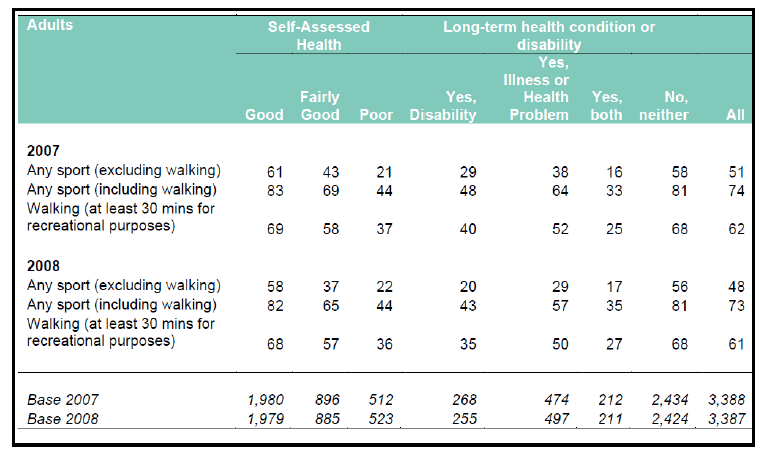Scottish Government Equality Outcomes: Disability Evidence Review
This evidence review was prepared to support the production of the Scottish Government's Equality Outcomes, with regard to disability.
14 Sport
14.1 This section reviews participation in sport by disabled children, and then by disabled adults. It closes with a look at barriers to sports participation.
Children
14.2 In a summary of sports research carried out over 15 years[97], the EHRC reports that:
- Only 24% of secondary school-aged disabled young people participate in two hours or more of Physical Education, compared with 53% of those without a disability;
- Only 15% of disabled secondary aged boys, and 10% of girls, are members of a sports club. This compares with 56% of boys and 36% of girls of secondary school age without a disability.
Adults
14.3 In the Scottish Health Survey 2012[98], a strong relationship between disability and physical activity was found: respondents with a long-term limiting condition were substantially less likely to meet the physical activity recommendations than respondents without. Only 26% of respondents with a limiting long-term condition met the physical activity recommendations, compared to 41% with a non-limiting condition, and 44% of those without a condition. Furthermore, only a third (36%) of those with such a condition participated in sport, compared to more than half (54%) of those without a condition.
14.4 The 2007/8 Scottish Household Survey[99] elaborates on participation in sport and health or disability status (see Table 16). Poor health and long term health conditions influence participation levels, with a clear decrease in sports participation as health worsens. In 2008, people with poor self-reported health had lower levels of participation (22% excluding walking) than those self reporting their health as good (37%) or very good (58%). Similarly, those who had no long term health condition or disability participated more (56%) than those who did (between 17% and 29%). Between 2007 and 2008 the decrease in participation excluding walking is most evident among those reporting good and fairly good health, whereas participation levels for those reporting poor health have been broadly stable. Note that care should be taken in drawing any conclusions about trends, as two years of data are not enough to establish a trend. Although the decrease in participation excluding walking is significant, it is only marginally so and further years of data are required before establishing whether there is a true downward trend.
Table 16: Participation in Sport in last 4 weeks by Health Status / Disability (Source: Scottish Household Survey, 2007/8)

Barriers to participating in sport
14.5 Research conducted in 2003[100] for the Department of Culture, Arts and Leisure, explored barriers to participation in certain sporting activities. It reported a perceived lack of physical activity or sport programmes for disabled people.
14.6 Research commissioned by Sportscotland[101] in 2001 aimed to provide an understanding of the barriers faced by disabled people with regard to participation in sport. The study explored internal barriers to sports participation, including feeling 'different' from the majority of the population, feeling unable to fit in, self-consciousness or lack of confidence and a fear of failure. It also explored external barriers, including lack of information, of physical and emotional support, appropriate facilities, transport problems, financial constraints, attitudes of others and lack of time.
14.7 These same barriers are reported in more recent research by the English Federation of Disability Sport (2012)[102], under three headings:
- logistical barriers, including suitable programmes, information, expense, and adequate support,
- physical barriers, such as facilities and equipment,
- psychological barriers - the feelings of disabled people, and the attitudes of others.
14.8 The research findings identify psychological barriers as the strongest hindrance to participation. They suggest a pathway to overcoming these barriers through increasing awareness, communication and provision.
14.9 An evaluation of community sport provision in Scotland (2007)[103] identified barriers to participation by people with mental health issues including the need to take medication during sessions, and the impact of a change in medication. One project stated that additional resources are needed to provide opportunities for people with mental health issues, and another project targeting beneficiaries with mental health issues stated that it is important to involve them in decision-making because this can help to empower beneficiaries by presenting them with choices. Providing transport was a difficult issue for a project targeting disabled beneficiaries who often need to travel substantial distances to attend specific sessions. A number of projects confirmed that providing transport is an on-going issue for disabled beneficiaries. On the other hand, capacity is being built: one project that engages wheelchair users is providing advice to other leisure centres on access.
Contact
Email: Social Research
There is a problem
Thanks for your feedback